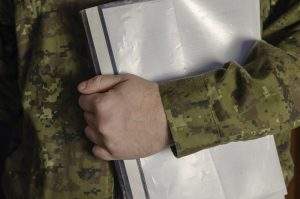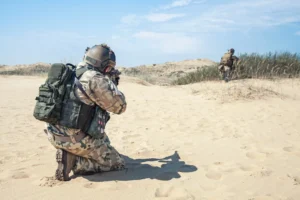On average, an American World War II veteran dies every three minutes. Another one will be gone by the time you finish reading this story.
The men and women who defeated Hitler and Tojo can’t beat Father Time, and their ranks are thinning at the rate of 413 per day.
But in the Tampa Bay area, some of these oldest soldiers are still contributing to the cause in their own way: They volunteer at local veterans hospitals.’
Among them are Charles Logsdon, 85, who watched an atomic bomb go off; Bob Stanton, 92, who has bits of German shrapnel in his body; Mary Millett, 91, who boiled needles at a Naval hospital; and Walter Skeldon, 90, who survived a kamikaze attack on his aircraft carrier.
They are volunteer patient escorts at the C.W. Bill Young VA Medical Center, formerly called Bay Pines. They push patients around in wheelchairs, taking them to medical clinics or physical therapy sessions. They provide a bit of company and conversation, and help patients navigate the medical center’s sprawling, maze-like campus.
“This is the only place where you can push people around and they don’t get mad at you,” joked Logsdon, a Navy veteran who retired in St. Petersburg. “I’ve been given so much, I feel I have to give back. It’d be so much easier just to sit home and watch TV, but that’s not for me.”
Veterans hospitals rely heavily on volunteers to escort patients, feed them, run errands and staff information desks. In Tampa, the James A. Haley VA Medical Center has 4,200 staffers and 1,200 volunteers at least two of whom are World War II veterans. And the Bay Pines VA Healthcare System, which includes Young VA as its main facility, has 3,800 employees and 1,800 volunteers.
Using military terms, Young VA spokesman Jason Dangel calls volunteers “a force multiplier.”
In March 1945, Bob Stanton was an infantryman with an M-1 rifle, riding through Germany on a half-track a military vehicle with tank treads in the rear and wheels in front.
As the Army’s 12th Armored Division approached the Rhine river, they engaged the enemy.
“An antitank shell hit the front of the half-track. Four of us survived out of 12 guys,” he recalled. “The sergeant got cut in half. I had a big hole in my leg.”
He has two Purple Hearts, a Bronze Star, and a souvenir: “I got a piece of German shrapnel right here,” he said, squeezing his left ear. “You can still feel it.”
Today, Stanton is a retired chemical engineer in Seminole with 18 grandchildren and seven great-grandchildren. He’s at the VA hospital two days a week.
“I push around 75-year-old guys in wheelchairs,” the 92-year-old said. “They say to me: ‘Listen, son, don’t get old.’ “
Florida has nearly 95,000 surviving World War II veterans, second only to the nation’s most populous state, California, according to the U.S. Department of Veterans Affairs.
Charles Logsdon is one. He enlisted in the Navy near the war’s end at the age of 15.
“I told them I was 17. They gave me a form to have my dad sign,” he said. “They weren’t too particular. They just wanted bodies.”
At the time, the U.S. was preparing for an invasion of Japan that never came. Instead, Logsdon witnessed an atomic bomb test in 1946 at the Bikini Atoll in the middle of the Pacific Ocean. He was stationed on a Navy destroyer 11 miles from ground zero.
“It was beyond words the most awesome sight you ever saw in your life,” he said. “There was no sound, just this huge spout going up, and this cloud was boiling and getting bigger.”
Decades later, the VA would treat his kidney cancer.
Today, he escorts patients alongside Mary Millett of Largo. She spent World War II as a corpsman a medic caring for the wounded at Brooklyn Naval Hospital. They didn’t have disposable needles back then, so she sterilized them by boiling them. They mixed medicine in glass vials over Bunsen burners.
“We had to have a mask for TB” to prevent tuberculosis infection “but we didn’t have them,” she said. “We had to make them out of Kleenex.”
One of the longest-serving volunteers at Young VA is Walter Skeldon. He spent the war on the decks of aircraft carriers in the Pacific, making sure cables caught the tailhooks of planes landing on the decks.
Early one morning Jan. 8, 1945 a Japanese kamikaze pilot broke away from an air battle and aimed his death dive at the U.S.S. Kadashan Bay. “He changed course and came right for us,” Skeldon recalled. The impact caused fires and flooding but failed to sink the ship.
Skeldon, who lives in Largo, was in the Navy for 28 years. He’s been volunteering at the VA hospital for 27 years.
“I want to put in one more year, so if I don’t beat the Navy, at least I tie ’em,” he said. “I plead insanity.”
Times researcher Carolyn Edds contributed to this report. Contact Mike Brassfield at brassfield@tampabay.com or (727) 445-4151. Follow @MikeBrassfield.
Editor’s note: This article was changed to reflect the following correction: Walter Skeldon, 90, of Largo is a World War II veteran who volunteers at the C.W. Bill Young VA Medical Center. An article last week misspelled his name.





